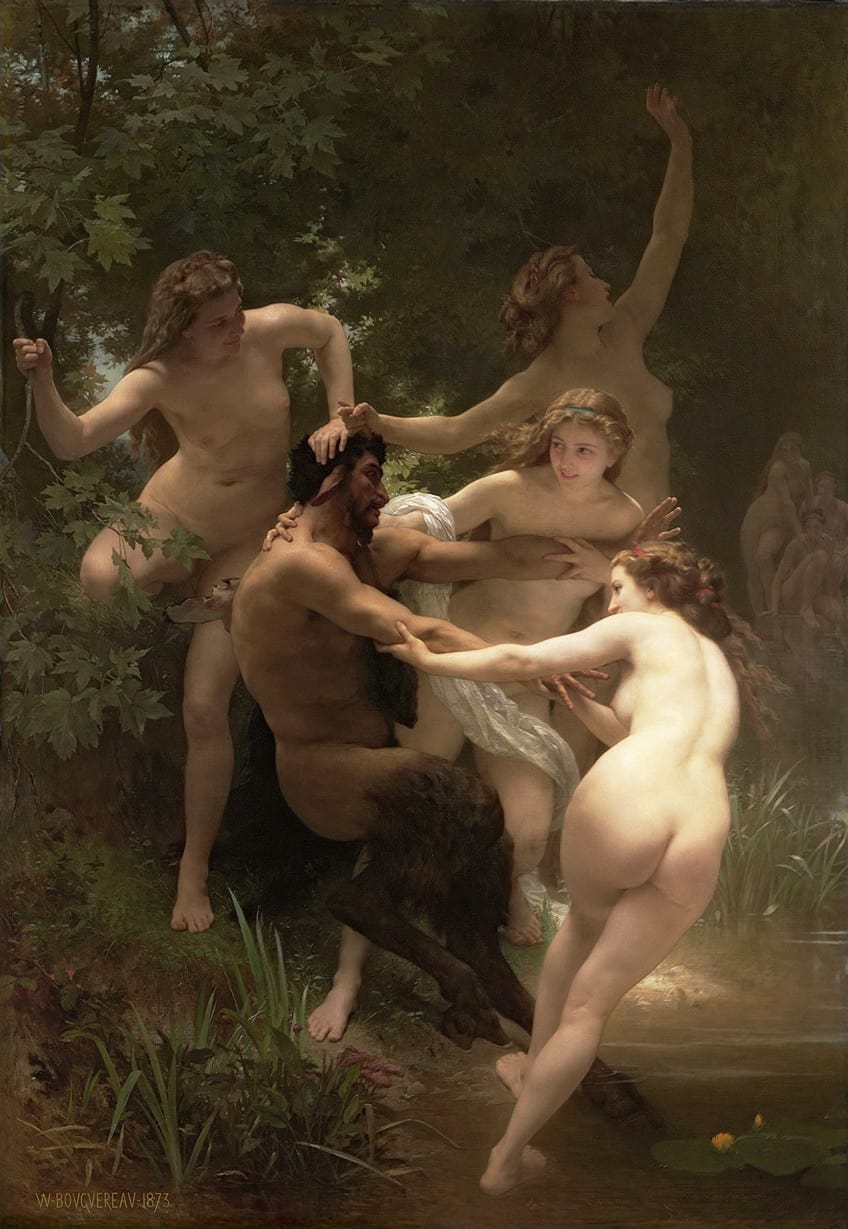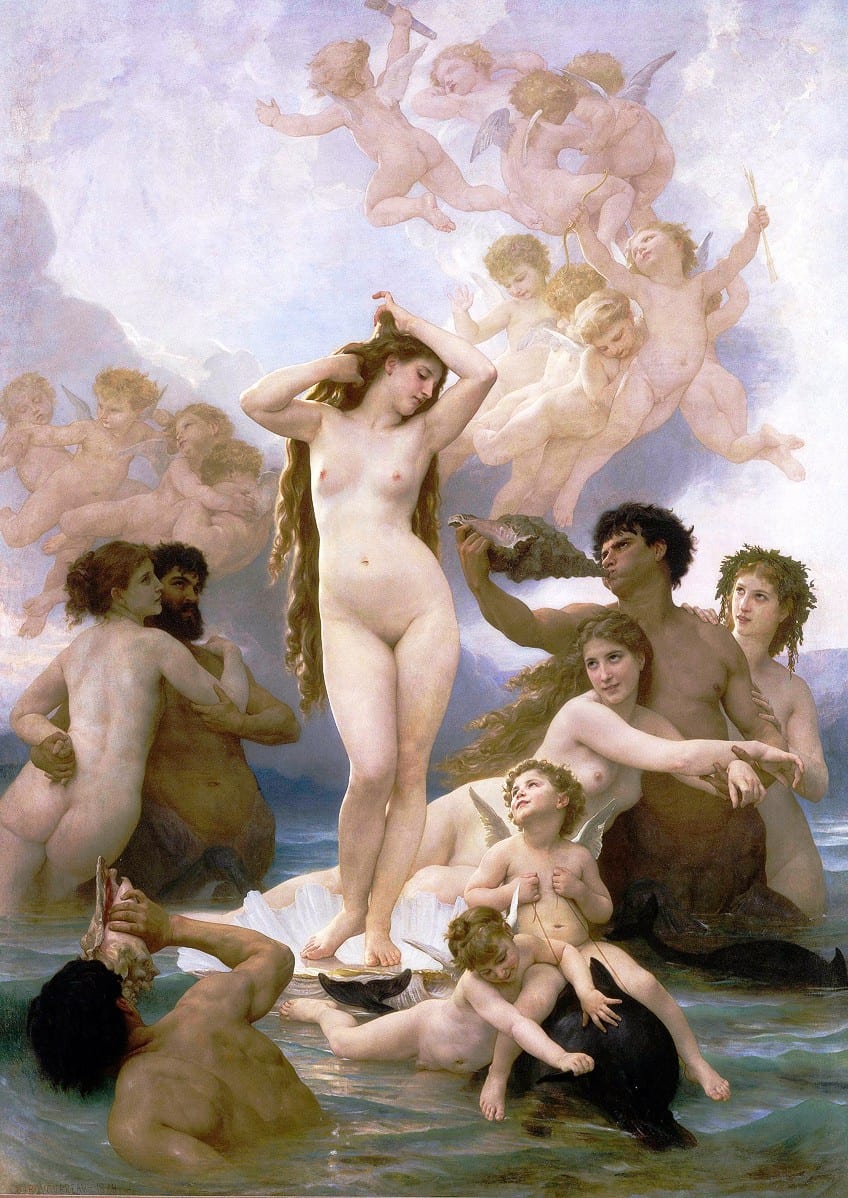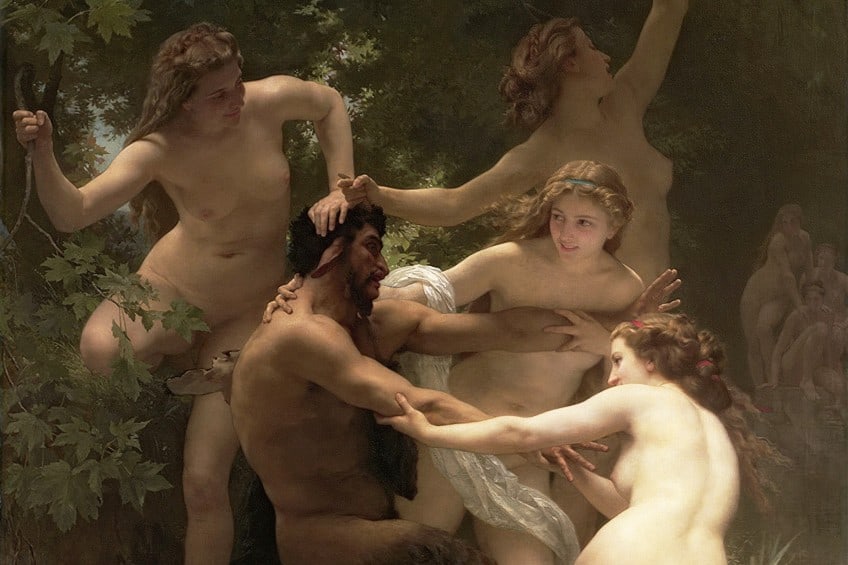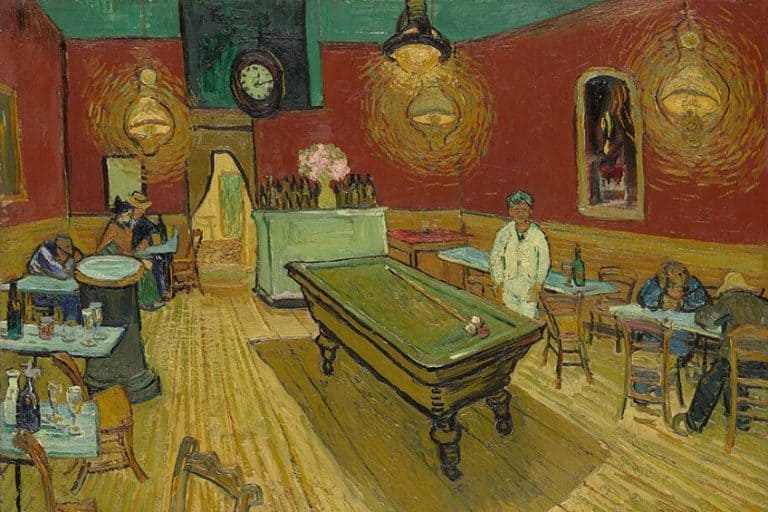“Nymphs and Satyr” by William-Adolphe Bouguereau – Ethereal Art
It was hung in a famous New York bar and then relegated to storage, only to be found again and hung in the Clark Art Institute in Massachusetts. This is Nymphs and Satyr (1873) by academic painter William-Adolphe Bouguereau, which is the painting this article will explore further.
Artist Abstract: Who Was William-Adolphe Bouguereau?
William-Adolphe Bouguereau was born in the city of La Rochelle in France on November 30, 1825, and died there on August 19, 1905. He was an Academic painter and studied under notable artists namely Louis Sage and François-Édouard Picot and at the École des Beaux-Arts.

He traveled to Rome when he won the Prix de Rome in 1850 and took part in the Paris Salon exhibitions. He was known for his skillful renderings of the female figure and painted subject matter that ranged from mythological scenes to genre paintings.
Examples of his artworks include “Dante and Virgil in Hell” (1850), “The Birth of Venus” (1879), and “The Young Shepherdess” (1885).
Nymphs and Satyr (1873) by William-Adolphe Bouguereau in Context
| Artist | William-Adolphe Bouguereau |
| Date Painted | 1873 |
| Medium | Oil on canvas |
| Genre | Mythological painting |
| Period/Movement | Academic art |
| Dimensions (cm) | 260.4 x 182.9 |
| Series/Versions | N/A |
| Where Is It Housed? | The Clark Art Institute, Williamstown, Massachusetts, United States |
| What It Is Worth | It was sold to John Wolfe for 35, 000 francs in 1873. Edward S. Stokes bought the painting in 1882, reportedly for $10, 000, from Catherine Lorillard Wolfe. After Stokes’ death in 1901, the painting was stored away by Daniel J. Leary and later found and acquired by Robert Sterling Clark in 1942, although the price is uncertain. |
The Nymphs and Satyr painting analysis will start with a brief contextual discussion about when William-Adolphe Bouguereau painted it including a description of the subject matter and who the mythological figures are, which will include a further look into the artist’s style of painting outlined by the art elements.
Contextual Analysis: A Brief Socio-Historical Overview
William-Adolphe Bouguereau completed the Nymphs and Satyr painting in 1873 and exhibited it the same year at the Paris Salon. It was believed to be inspired by a poem by Publius Papinius Statius, who was a Roman poet active during the 1st century CE.
The line from the poem has been quoted often and is as follows: “Conscious of his shaggy hide and from childhood untaught to swim, he dares not trust himself to deep waters”.
This line undoubtedly refers to the satyr who cannot swim and provides a basis on which to understand the moment Bouguereau is depicted in the Nymphs and Satyr painting and why the satyr seems so reluctant to enter the water.
Nymphs, Satyrs, Sexuality, and Hotel Bars
After being founded by Robert Sterling Clark in 1942, and when the Clark Art Institute in Williamstown, Massachusetts, United States started in 1955, the Nymphs and Satyr painting had an interesting journey before it made its way into the museum’s collection. The Nymphs and Satyr painting was initially bought by John Wolfe for 35, 000 francs on June 26, 1873; he was an art collector from America.
In 1882, Edward S. Stokes bought the painting, reportedly for $10, 000, from Catherine Lorillard Wolfe, who was John David Wolfe’s daughter, and the inheritor of his collection of paintings when he died. She reportedly placed the painting on auction through Leavitt & Co.
Edward Stokes was the owner/manager of the famed and fabulous Hoffman House Hotel in New York, and its saloon/bar was the spot he chose to hang the infamous Nymphs and Satyr painting. It was a feast for all eyes, which mostly consisted of the male gaze, but its overt sexuality was enticing to the overall American gaze – the canvas made its journey from Europe to America, especially during the conservative Victorian era.

The nudity in the Nymphs and Satyr painting was somewhat different from what was expected for Academic paintings, it was overtly compared to the more acceptable coy nature nudes had in art. It was a canvas that catalyzed change in the discourses of sexuality, nudity, and feminism.
When Stokes died in 1901, the painting was reportedly placed into storage with some theories suggesting because of its provocative subject matter.
Reportedly, Daniel J. Leary was eventually in possession of the painting and it was through him that it was sold to Robert Sterling Clark. According to sources around the painting’s provenance, Herbert H. Elfers found the painting in storage and was the agent for Clark.
Formal Analysis: A Brief Compositional Overview
The Nymphs and Satyr painting analysis will provide a visual description of the subject matter including the formal art elements and how these compose the work of art, which Bouguereau created according to classical principles of composition and reportedly produced preparatory sketches and utilized models that enhanced the realistic effect of his paintings.

Subject Matter: Visual Description
The Nymphs and Satyr painting depicts a group of five mythological figures in the center of the foreground and towards the middle ground of the composition. There are four nymphs playfully touching and tugging at a satyr attempting to pull him into a body of water to the right; they appear to be standing on an embankment. Although the satyr’s left hoof is in the water, he appears reluctant to move forward, as if afraid of the water.
The figures are surrounded by a lush, forested area, with part of a blue sky and a possible landscape slightly visible through the greenery in the left corner.
The nymphs are believed to have bathed before they discovered the satyr watching them. He undoubtedly startled them as there appears to be three more nymphs hiding to the right in the background of the composition. The nymphs are all nude except for a white silky piece of fabric loosely hanging over the nymph holding onto the satyr’s left arm. It is draped around her upper right arm and falls across her waist, covering her genitalia, and over her left thigh to behind her left foot.

Furthermore, Bouguereau also covered the other figures’ genitalia through various pictorial means. He positioned the nymph to the right with her back to us, the viewers, and the nymph to the left is holding on to part of a thin tree branch, of which the leaves cover her genitalia. The satyr’s genitalia are covered by his right leg.
Color
William-Adolphe Bouguereau’s color scheme in the Nymphs and Satyr painting depicts a realism that the artist was well-known for and skilled at conveying in his paintings. Notice the realistic rendering of the flesh tones of the nymphs, including the contrasts between light and dark as they move in between the light and shade in the forest.
Texture
Bouguereau’s brushwork appears smoothly applied and with a sense of realism that implies naturalistic textures with minimal to no brushstroke visibility. His work has often been described as “hyperreal”. Examples include the figures’ soft and silky skin, and their suppleness is conveyed by the soft indents created by the nymphs’ hands on the satyr.
Furthermore, the white piece of fabric appears diaphanous in its soft folds, and noticeable to are the striations of the leaves. A contrasting coarser texture is created by the ground below the figures.

Line
Nymphs and Satyr by William-Adolphe Bouguereau are composed of a variety of organic lines created by the intermingling of the figures in the foreground. These also convey a sense of movement and dynamism. The artist also created outlines through color gradations, which delineate the various forms. There are also directional lines implied by the positioning of the figures, as the nymphs are pulling at the satyr, and as he resists the forward tug to the water, a forward movement is implied.
Furthermore, the figures appear at a slant on the embankment, which creates a diagonal directional linearity.
Shape and Form
Organic shapes and forms compose the painting Nymphs and Satyr by William-Adolphe Bouguereau. There is also a three-dimensionality in the form of the figures, which is created by other art elements like color, shading, and highlights.

Space
William-Adolphe Bouguereau created a three-dimensional space in his Nymphs and Satyr painting through shading and highlights, as well as through a diminished scale and size, hazing, creating slightly blurred effects, for the figures in the background to provide the illusion of depth.
Furthermore, the figures in the foreground are clearer and in focus, which provides emphasis on them as the main focal points.
Bouguereau: Flaunting the Flirtatious
The Nymphs and Satyr painting analysis above explored a closer look at one of William-Adolphe Bouguereau’s lauded, and critiqued, artworks. It was produced during a time of the burgeoning Impressionism art style too, which the artist was stylistically at odds with.

Nevertheless, “Nymphs and Satyr” by William-Adolphe Bouguereau has been an iconic painting since its inception in the art world. From Paris to New York, it has boasted Bouguereau’s skill as an academic painter and flaunted the flirtatious through mythological characters in an era of conservative gazes.
Frequently Asked Questions
Who Painted Nymphs and Satyr (1873)?
The French academic painter, William-Adolphe Bouguereau, painted Nymphs and Satyr (1873). It is an oil on canvas, measuring 260.4 x 182.9 centimeters. Its exhibition was at the Paris Salon in 1873.
Where Is Nymphs and Satyr by William-Adolphe Bouguereau Located?
The Clark Art Institute in Massachusetts, United States is home to the oil on canvas Nymphs and Satyr (1873) It was acquired by the museum’s founder, Robert Sterling Clark, in 1942 and has been there since its opening in 1955.
What Is the Meaning of Nymphs and Satyr by William-Adolphe Bouguereau?
The oil on canvas titled Nymphs and Satyr (1873) depicts mythological figures, namely several nymphs and one satyr in a forest. The painting was reportedly inspired by a Latin poem by Publius Statius. It was also considered a visual exploration of the artist’s skill at painting the nude female figure.
Alicia du Plessis is a multidisciplinary writer. She completed her Bachelor of Arts degree, majoring in Art History and Classical Civilization, as well as two Honors, namely, in Art History and Education and Development, at the University of KwaZulu-Natal, South Africa. For her main Honors project in Art History, she explored perceptions of the San Bushmen’s identity and the concept of the “Other”. She has also looked at the use of photography in art and how it has been used to portray people’s lives.
Alicia’s other areas of interest in Art History include the process of writing about Art History and how to analyze paintings. Some of her favorite art movements include Impressionism and German Expressionism. She is yet to complete her Masters in Art History (she would like to do this abroad in Europe) having given it some time to first develop more professional experience with the interest to one day lecture it too.
Alicia has been working for artincontext.com since 2021 as an author and art history expert. She has specialized in painting analysis and is covering most of our painting analysis.
Learn more about Alicia du Plessis and the Art in Context Team.
Cite this Article
Alicia, du Plessis, ““Nymphs and Satyr” by William-Adolphe Bouguereau – Ethereal Art.” Art in Context. July 6, 2023. URL: https://artincontext.org/nymphs-and-satyr-by-william-adolphe-bouguereau/
du Plessis, A. (2023, 6 July). “Nymphs and Satyr” by William-Adolphe Bouguereau – Ethereal Art. Art in Context. https://artincontext.org/nymphs-and-satyr-by-william-adolphe-bouguereau/
du Plessis, Alicia. ““Nymphs and Satyr” by William-Adolphe Bouguereau – Ethereal Art.” Art in Context, July 6, 2023. https://artincontext.org/nymphs-and-satyr-by-william-adolphe-bouguereau/.











